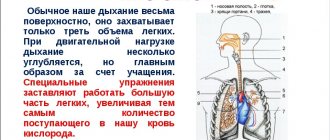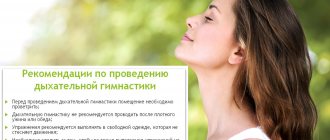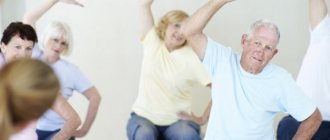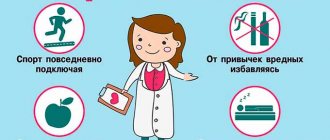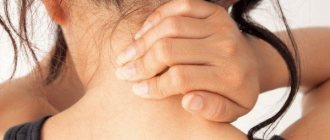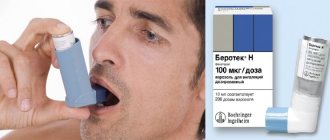What are the benefits of breathing exercises for hypertension?
Normal human breathing is shallow, using only a third of the lung capacity. Due to frequent stress, overexertion, and fatigue, the pulmonary arteries become spasmed. As a result, tissues and organs do not receive enough oxygen, and lungs that work at half capacity become the cause of frequent colds, cardiovascular and nervous disorders.
During oxygen starvation, the brain sends impulses that constrict blood vessels to increase the speed of blood flow and provide the organs with oxygen and nutrients. This process causes an increase in blood pressure. With constant hypoxia, chronic hypertension develops.
Correct, deep breathing saturates the blood with oxygen, reduces cardiac stress, dilates blood vessels, which helps reduce blood pressure. Regularly performing a set of breathing exercises speeds up metabolism, improves lipid metabolism, and improves psycho-emotional state.
Indications for use
Breathing exercises are used as additional therapy for:
- diseases of the upper respiratory tract;
- malfunctions of the digestive tract;
- high cholesterol;
- obesity;
- cardiovascular diseases;
- anemia;
- stress, depression, psycho-emotional stress;
- heavy physical and mental work;
- diabetes mellitus;
- diseases of the thyroid gland.
Breathing exercises help improve the well-being of those who quit smoking. They eliminate shortness of breath, normalize metabolism, and the body quickly cleanses itself of toxins and waste.
System advantages
Breathing exercises have many advantages and strengths:
- the system can be used as an independent program or complemented with a complex of exercise therapy and other sports activities;
- saturation of organs with oxygen improves their functionality, increases human performance and endurance;
- intolerance to breathing exercises is very rare and most often occurs due to incorrect technique;
- The technique can be used by elderly people and children.
The combination of proper breathing and cyclic sports to reduce blood pressure gives faster, more sustainable results and allows you to get rid of the initial stage of hypertension.
Causes of changes in blood pressure
Let's look at the most common ones:
- Excessive abuse of bad habits;
- Poor nutrition and possible subsequent obesity;
- Common kidney diseases;
- Leading a passive lifestyle;
- Frequent stress and nervous tension.
Often, hypertensive patients think about the question, how long can they live due to their disease? In this case, the answer lies in the patient’s lifestyle and his attitude towards his body.
If you give up bad habits and bring your lifestyle back to normal, as well as regularly do breathing exercises for hypertension and perform other exercises, then you can live a long, happy life without regularly worrying about the disease.
If we consider medications separately, they can only temporarily relieve the symptoms of the disease, but the disease will return again and it is possible that with even greater force and threat to life.
Important! Regular use of medications for hypertension only delays the development of the disease; after stopping them, the disease returns again with even greater force, which is why many patients continue to take pills constantly, thereby destroying other vital organs.
Rules for doing exercises for hypertension
To get the maximum benefit from your training, you need to follow a few simple rules:
- Before classes, ventilate the room.
- Gymnastics is done before meals.
- Inhale only through the nose. The inhalation is noisy, short, active. The biggest mistake is to hold out your inhalation to take in more air, inflating yourself as much as you can.
- Take as many breaths in a row as you can easily afford. In severe conditions, the exercises are performed sitting or lying down, in normal conditions – while standing. The worse you feel, the more you need to do gymnastics, but rest more often.
- The load is increased gradually, listening to your feelings.
Before training using any method, you need to do a light two-minute warm-up to warm up. This could be squats, swinging your arms, rotating your head from side to side, running in place.
Gymnastics Strelnikova
Initially, the Strelnikova breathing method was used to restore the voice. Studies on the effectiveness of gymnastics have shown that it strengthens the vocal cords, lowers blood pressure, and increases the body's resistance to viral infections. Used as a means of additional therapy for people suffering from asthma, arrhythmia, shortness of breath, and osteochondrosis.
The basic complex consists of 12 simple exercises:
- Palms. Standing, raise your hands to your shoulders, turning your palms away from you. Inhaling, clench your fists tightly, exhaling, relax, but do not lower your arms.
- Shoulder straps. Standing, clench your fists, press them to your stomach, tense your arms and shoulders. Inhale – stretch your arms forward, unclench your fists, spreading your fingers as far apart as possible.
- Pump. Bend slightly towards the floor at an angle of 900 C, round your back, arms straight. Inhaling, slightly raise your torso, but do not straighten it completely, exhale – bend towards the floor again, maintaining a right angle.
- Cat. Standing, bend your elbows, press them to your sides, relax your hands. Inhale - bend your legs slightly, turn your torso to the side, and grab the air with your hands. Exhale – take the starting position.
- Ears. Inhale - tilt your head to the side, trying to touch your ear to your shoulder, exhale - return to the starting position.
- Hug your shoulders. Place your hands on your collarbones. Inhaling, wrap your arms around yourself so that your elbows come together at one point.
- Big pendulum. Consists of two exercises: “hug your shoulders”, “pump”, do it in turns.
- Head turns. Inhale - turn your head to the left, exhale - start position, look straight ahead. The next breath is a turn in the other direction.
- Pendulum head. While inhaling, tilt your head forward, trying to touch your chin to your chest, and while exhaling, straighten your head. The next inhalation - carefully tilt your head back, exhale - take the starting position. If you have high blood pressure, you need to do this exercise slowly and carefully to avoid dizziness.
- Rolls - stand up straight, bend your arms, press them to your sides, put your right leg slightly forward. Inhale - transfer your body weight to your forward leg, bending it slightly. Exhale – take the starting position.
- Forward step. Inhaling, raise the bent leg to the stomach, bend the other slightly. Do it alternately with each leg.
- Back step. Inhale - the leg is pulled back, trying to touch the heel of the buttock, the supporting buttock is slightly bent. Do it alternately with each leg.
Each exercise is done 32 times, that is, there should be 32 inhalations and movements. The first three days – 1 approach, 1 time/day. Next 2 approaches, 1 time/day. Starting from the second week, the number of approaches is increased to 3, preferably performed in the morning and evening.
Buteyko method
Breathing according to the Buteyko system helps with hypertension, bronchial asthma, diseases of the ENT organs, eliminates shortness of breath and vascular spasms. Increases overall tone, performance, improves sleep and digestion. A set of exercises is recommended to be performed during rehabilitation after a heart attack or stroke.
The essence of the technique is to reduce breathing by relaxing the muscles, learn to breathe smoothly and slowly, without deep and frequent breaths.
To reduce blood pressure, do the following every day:
- Breathing with a relaxed diaphragm. While sitting or reclining, relax your diaphragm as much as possible and breathe shallowly through your nose for 1-2 minutes.
- Holding your breath while moving. Close your nostrils with your fingers and do not breathe for as long as possible. The exercise is repeated 3 times, fully restoring breathing after each delay.
Basic training rules:
- It is advisable to always, not only during gymnastics, breathe through your nose. Even if it is laid down, it will gradually begin to unfold.
- Make breathing even, reduce its depth through relaxation.
- Do not overdo it, do not allow acute lack of air.
A sign of proper exercise performance is the absence of the desire to breathe after training.
How to exercise correctly?
It is important to remember the basic rules when performing exercises:
- Choose well-ventilated areas for classes.
- Your clothes should not pinch, press, restrict your body or hinder movement. It is better to choose things made from natural fabrics so that the skin can breathe.
- Increase the load gradually. Start small. Don't immediately rush to the embrasure.
- Regularity is important in classes. The recommended frequency of exercise is 3-4 times a week for approximately 30 minutes.
- Monitor your condition and control your pulse. Stop exercising if discomfort or unpleasant symptoms appear.
Breathing according to Evdokimenko
How to use breathing to reduce blood pressure and get rid of hypertension? For this purpose, Dr. Evdokimenko has developed a special technique of inhalation and exhalation, which completely eliminates symptoms and is effective for stages I-II of the disease.
Breathing exercises improve blood flow through the vessels, stabilize blood circulation, and lower blood pressure to normal.
Gymnastics consists of three exercises:
- Rotating the head improves blood circulation in the collar area of the neck and brain. Perform while sitting, back straight, shoulders straight. Tilt your head forward and touch your chin to your chest. Make circular movements, first to the right, then to the left: 20 times in each direction. After the first approach, straighten your head, inhale and exhale sharply 10 times, rest for 3 minutes. Do 2 more approaches.
- Abdominal breathing - performed while sitting or lying down. One hand is placed on the stomach, the other on the chest. Inhaling slowly, fill the abdominal cavity with air. As soon as the stomach is filled with oxygen, you need to take a deep breath into the chest, although it will seem that there is no room left for air. Inhale, hold your breath for 7 seconds, exhale smoothly and hold your breath for another 7 seconds. Then rest for 1 minute and repeat the exercise 5 times.
- Exhale slowly - perform while lying down. Inhalation is done exactly the same as in the second exercise. Exhale - first release the abdominal cavity, then the chest. You need to exhale 3 times slower than inhale. Repeat 5 times, taking 1 minute breaks between exercises.
With high blood pressure, it is advisable to combine Evdokimenko breathing with cardiac exercises for better training of the heart muscle.
Drawing conclusions
Heart attacks and strokes are the cause of almost 70% of all deaths in the world. Seven out of ten people die due to blockages in the arteries of the heart or brain.
What’s especially scary is the fact that a lot of people don’t even suspect that they have hypertension. And they miss the opportunity to fix something, simply dooming themselves to death.
Symptoms of hypertension:
- Headache
- Increased heart rate
- Black dots before the eyes (floaters)
- Apathy, irritability, drowsiness
- Blurred vision
- Sweating
- Chronic fatigue
- Swelling of the face
- Numbness and chills in fingers
- Pressure surges
If you have any questions, ask them here
Did you like the article? Write your opinion in the comments. Subscribe to our FB:
Proper breathing is an effective method of relieving high blood pressure, restores vascular tone, improves blood flow, saturates tissues and blood with oxygen, and quickly relieves symptoms of the disease.
Qigong system
Chinese gymnastics is a system of breathing and movement exercises. Used for preventive and therapeutic purposes for high blood pressure and other diseases. The main principle of the method is the movement of air and energy from bottom to top.
To improve blood flow, heart function, blood vessels, and muscles, the following exercises are suitable:
- Stand straight, feet slightly wider than shoulder-width apart. Inhale - rise on your toes, exhale - roll onto your heels. Do it 10 times. It is advisable to gradually increase the range of movements, each time rising higher and higher on your toes.
- Stand up straight, look ahead, back straight. Inhale – sit down, place your palms on your knees. Exhale – take the starting position. They do it slowly, each time they try to sit deeper, and when lifting, they slightly push their knees back.
- Stand straight, feet shoulder-width apart. Inhaling, raise your leg and pull it with your hands to your body, exhaling - slowly lower it. Repeat 5 times for each leg.
- Inhale – move your shoulders forward as much as possible, lift them up. Exhale – move your shoulders back as far as possible, lower. Repeat 10 times.
- Inhale - arch your back as much as possible, bring your elbows forward, exhale - bend your back forward, move your elbows and shoulders back.
- The complex is completed by rotating the head - 5 circles to the right and left.
During gymnastics, there is a constant exchange of oxygen with carbon dioxide, which restores the normal functioning of the circulatory system and lowers blood pressure.
Shishonin method
The system consists of simple exercises based on belly breathing. During inhalation, active contraction of the diaphragm and proper breathing relieve headaches due to hypertension, improve blood supply to the heart, brain, and lungs.
To reduce blood pressure, just do two simple exercises every day:
- Inhale deeply with your stomach without expanding your chest. Hold the air for 10 seconds, exhale slowly, wait 5-10 seconds.
- While inhaling with your stomach, raise your arms up, while exhaling, slowly lower them down, wait 5-10 seconds.
Each exercise is repeated 20-30 times.
Contraindications
For patients with stage 1 and 2 hypertension, exercise therapy and gymnastics are contraindicated if:
- Blood pressure over 180/120 mmHg;
- Post-hypertensive crisis. When the general condition has worsened and the blood pressure level has decreased by 20-30% compared to the original;
- Risk of developing myocardial infarction;
- Possibility of developing a stroke;
- Atrial fibrillation;
- Extrasystoles, paroxysmal tachycardia;
- Weakness, shortness of breath, angina attacks;
- Thromboembolism and thrombosis.
It is important to remember that physical therapy for hypertensive patients excludes heavy exertion! For example, lifting weights and shuttle running.
If chest pain, shortness of breath, or interruptions in heart rate occur during exercise, you should stop training and consult a physician.
Gymnastic complexes and intensity of exercises must be coordinated with the attending doctor and exercise therapy methodologist. Author of the article Svetlana Anatolyevna Ivanova, general practitioner
Bubnovsky system
S. M. Bubnovsky developed a set of exercises to normalize the functioning of the heart, blood vessels, and improve blood circulation.
Sequence of gymnastics:
- Get down on all fours, relax, stand like that for 2-4 minutes.
- Standing on all fours, exhale, slowly arch your back up, and while inhaling, slowly bend your back down. Start with 10 repetitions, gradually increase to 30.
- From a standing position, take a step forward, bend your front leg, lean your palms on it, the back leg remains extended. Inhale – extend your arms above your head, join your palms, hold your breath for 5 seconds. Exhale - slowly return to the starting position. Pause for 10 seconds and repeat the exercise, changing legs. Do 7 repetitions, 10 times for each leg.
Bubnovsky breathing is suitable for the prevention and treatment of the initial stage of hypertension.
